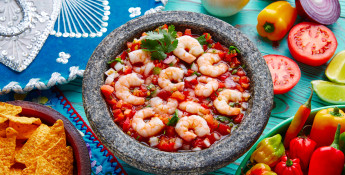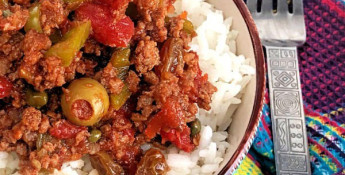By Chef Alli on June 30, 2020
A Guide to Processed Tomato Products

When we can't get perfect summer tomatoes, it’s super convenient to use processed tomatoes for our favorite sauces, soups and sides. I like to keep my pantry as well stocked as possible with various types of tomato products, and I’m sure you do, too.
They are essential for making quick week night meals and are necessary for making cheese dips, Mexican dishes and big pots of chili.
But what are the best and most useful varieties to keep on hand? The options seem endless and sometimes I feel overwhelmed when looking at all the choices available at the grocery store.
For instance, how are stewed tomatoes different from diced tomatoes? Are crushed tomatoes interchangeable with tomato purée in a recipe? Why is tomato paste so darn thick? What are sun-dried tomatoes and how are they best used?
Below is a processed tomato guide that may help you know what will work best for your style of cooking and the recipes you make most often.
Whole Tomatoes
Generally sold peeled, whole tomatoes come packed in either juice or puree and are usually a high quality tomato product. If your recipe calls for crushed tomatoes, simply break the tomatoes up with your fingers as they go into the pot or bowl, adding juices as needed. Many a marina has started with whole tomatoes!
Commercial packers and canners typically save their ripest, least-blemished and most attractively-colored specimens for canned whole tomatoes. Lesser tomatoes are reserved for use in tomato paste, puree or sauce.
Diced Tomatoes
Diced tomatoes are tomato chunks packed in tomato juice and are an excellent cooking timesaver. Diced tomatoes are typically firm, perfect for long-simmered savory dishes that need distinct pieces of tomatoes as part of the end result.
Petite Diced Tomatoes
Offering smaller tomato pieces, petite diced tomatoes have a more delicate mouth feel. Petite diced tomatoes are packed in tomato juice and have the same flavor as diced tomatoes.
Fire-Roasted Tomatoes
Tomatoes charred over a flame before they are diced and canned are fire-roasted tomatoes. When you open a can of fire-roasted tomatoes, expect to see black flecks and pieces of char on the tomatoes and in their juice, adding a nice smoky flavor to the recipe you are making. Fire-roasted tomatoes are often enhanced with other aromatics, such as onions, garlic and bell peppers.
Crushed Tomatoes
Crushed tomatoes are a mixture of diced tomatoes with tomato paste or tomato purée. Crushed tomato pieces are smaller in size than petite diced tomatoes but not quite as smooth in consistency.
Stewed Tomatoes
Cooked before they are canned, these tomatoes are stewed (gently cooked) giving them a softer texture than other canned variety of tomatoes. Stewed tomatoes are typically seasoned and have added sugar that cuts the acidity of the tomatoes and their juices.
Tomato Sauce
Tomato sauce is not the same as spaghetti or marinara sauce, though they are all smooth in texture. Tomato sauce made from tomato puree offers better flavor than those made from a combination of water and tomato paste; read the label to check the ingredients. Tomato sauce is a great base when making stews, soups and casseroles.
Tomato Paste
When tomatoes are slow-cooked until all the liquid is evaporated, the end result is a thick, concentrated tomato paste. Tomato paste can enrich the flavors of a dish, especially when the tomato paste is cooked until the color turns from bright red to a deep brown.
Some tomato paste comes in small cans since a little goes a long way. Because most recipes only call for a small amount of tomato paste, many cooks prefer the tomato paste that is sold in tubes to reduce waste (once opened, the tube of tomato paste must be stored in the fridge). Keep in mind that unlike other tomato products that get mushy when frozen and thawed, leftover tomato paste fares quite well when frozen.
Chef Alli Pro Tip For Leftover Canned Tomato Paste: Use a tablespoon-size cookie dough scoop to scoop the paste onto a baking sheet. Place the baking sheet into the freezer; once the tomato paste portions are frozen solid, remove them to a freezer bag. This method allows you to easily grab as much or as little for your next recipe.
Diced Tomatoes and Green Chilies
Just as the name says, green chilies are added to diced tomatoes, then canned. Green chilies are mild, chopped Anaheim peppers that add a bit of zest and zing to any dish. Used frequently for warm cheese dips and Mexican dishes (plus many others), diced tomatoes and green chilies jazz up many a recipe.
Italian Tomatoes
Most cooks would agree that superior Italian tomatoes are made from the very-specific San Marzano variety of plum tomatoes. Famous for their for rich, sweet flavor, tender texture, mild acidity and few seeds, San Maranzo tomatoes are basically the only recognized name in canned-tomatoes.
Said to be extraordinarily delicious and meaty for making ideal sauces, San Marzano tomatoes are protected and regulated under Italian law and will have a D.O.P. seal (Denominazione di Origine Protetta which means “Protected Designation of Origin”) denoting so. Don’t be fooled and always check canned tomato labels closely. Many canned tomatoes have labeling that may boast "San Marzano-Style Tomatoes." They are not the same.
Sundried Tomatoes
For very intense tomato flavor, sun-dried tomatoes are a definite go-to for savory dishes, though they are not always found in the same aisle or area of your grocer as canned tomato products. I often find jarred sun-dried tomatoes in the produce department, near the garlic and fresh tomatoes.
Dried sun-dried tomatoes can be reconstituted with hot liquids, and you’ll find sun-dried tomatoes that are packed in oil. Between the two, I really prefer the oil-packed option since the sun-dried tomatoes are already very tender. What you don’t use from the jar will keep for quite some time in refrigeration.
How are commercially canned tomatoes processed?
First, the tomatoes are picked at their peak ripeness and processed immediately; many commercial canning facilities are located near the farms where their tomatoes are grown.
Next, the tomato skins are removed, either by steaming or a hot water bath.
Once the skins are removed, the tomatoes go into cans along with salt for seasoning and either tomato juice or tomato puree.
Lastly, the cans are sealed and heated, and held at a specific temperature until the contents are sterile. This sterilization process actually cooks the tomatoes right in the can.
How long do canned tomato products last?
Canned tomatoes last 12-18 months at room temperature when stored in your pantry. The longer canned tomatoes sit, however, the more they acquire a “tinny-ish” flavor, so rotate.
When using canned tomatoes, transfer any leftovers from an opened can to a storage container. Once refrigerated, canned tomatoes will keep for 5-7 days. (Canned tomatoes do not freeze well since they turn to mush once thawed.)




